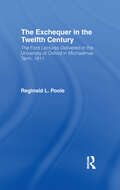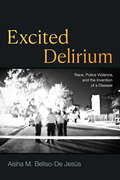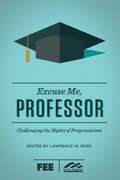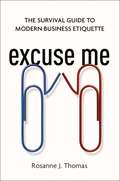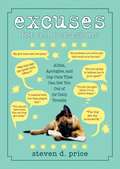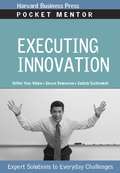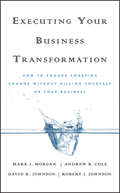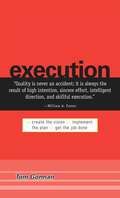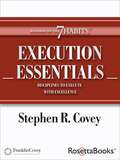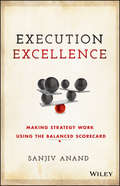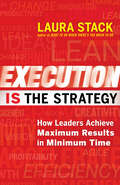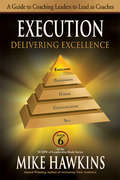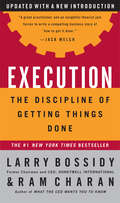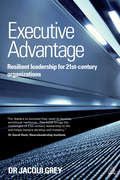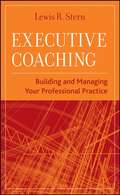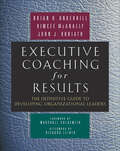- Table View
- List View
Exchequer in the 12th Century: The Ford Lectures Delivered In The University Of Oxford, In Michaelmas Term, 1911 (classic Reprint)
by R. L. PooleFirst Published in 1973. Routledge is an imprint of Taylor & Francis, an informa company.
Excited Delirium: Race, Police Violence, and the Invention of a Disease
by Aisha M. Beliso-De JesúsIn 1980, Charles Wetli---a Miami-based medical examiner and self-proclaimed “cult expert” of Afro-Caribbean religions---identified what he called “excited delirium syndrome.” Soon, medical examiners began using the syndrome regularly to describe the deaths of Black men and women during interactions with police. Police and medical examiners claimed that Black people with so-called excited delirium exhibited superhuman strength induced from narcotics abuse. It was fatal heart failure that killed them, examiners said, not forceful police restraints. In Excited Delirium, Aisha M. Beliso-De Jesús examines this fabricated medical diagnosis and its use to justify and erase police violence against Black and Brown communities. Exposing excited delirium syndrome’s flawed diagnostic criteria, she outlines its inextricable ties to the criminalization of Afro-Latiné religions. Beliso-De Jesús demonstrates that it is yet a further example of the systemic racism that pervades law enforcement in which the culpability for state violence is shifted from the state onto its victims. In so doing, she furthers understanding of the complex layers of medicalized state-sanctioned violence against people of color in the United States.
Exciting Times: Longlisted for the Women's Prize for Fiction 2021
by Naoise Dolan'The book of the summer ... Kept me rapt until the final page' THE TIMES'A sharp, smart, witty modern love story. I loved it' David Nicholls, author of ONE DAY'More than lives up to the hype ... Likely to fill the Sally-Rooney-shaped hole in many readers' lives' IRISH TIMES'Droll, shrewd and unafraid - a winning debut' Hilary Mantel, author of WOLF HALL'I've been pushing Exciting Times on everyone I know. Some of Dolan's pithy observations of her characters are the best I've read since Edward St Aubyn' OBSERVER'A frankly sensational book' Pandora Sykes on THE HIGH LOW'In the tradition of Dorothy Parker, Joan Rivers and Nora Ephron ... I found myself purring with pleasure. ...This is comic writing at the highest level' Craig Brown, DAILY MAILWhen you leave Ireland aged 22 to spend your parents' money, it's called a gap year. When Ava leaves Ireland aged 22 to make her own money, she's not sure what to call it, but it involves:- a badly-paid job in Hong Kong, teaching English grammar to rich children;- Julian, who likes to spend money on Ava and lets her move into his guest room;- Edith, who Ava meets while Julian is out of town and actually listens to her when she talks;- money, love, cynicism, unspoken feelings and unlikely connections.Exciting times ensue.
Excommunication for Debt in Late Medieval France: The Business of Salvation
by Tyler LangeLate medieval church courts frequently excommunicated debtors at the request of their creditors. Tyler Lange analyzes over 11,000 excommunications between 1380 and 1530 in order to explore the forms, rhythms, and cultural significance of the practice. Three case studies demonstrate how excommunication for debt facilitated minor transactions in an age of scarce small-denomination coinage and how interest-free loans and sales credits could be viewed as encouraging the relations of charitable exchange that were supposed to exist between members of Christ's body. Lange also demonstrates how from 1500 or so believers gradually turned away from the practice and towards secular courts, at the same time as they retained the moralized, economically irrational conception of indebtedness we have yet to shake. The demand-driven rise and fall of excommunication for debt reveals how believers began to reshape the institutional Church well before Martin Luther posted his theses.
Excuse Me, Professor: Challenging the Myths of Progressivism
by Ron Robinson Lawrence W. ReedThere's little truly "progressive" about Progressivism. True progress happens when humans are free, yet the Progressive agenda substantially diminishes freedom while promising the unachievable. Excuse Me, Professor provides a handy reference for anyone actively engaged in advancing liberty, with essential essays debunking more than 50 Progressive clichés.Does the free market truly ignore the poor? Are humans really destroying the Earth? Is the government truly the first best source to relieve distress?Compiled and edited by Lawrence W. Reed in collaboration with the Foundation for Economic Education and Young America's Foundation, this anthology is an indispensable addition to every freedom lover's arsenal of intellectual ammunition.
Excuse Me: The Survival Guide to Modern Business Etiquette
by Rosanne J. ThomasBlending different generations, genders, and cultures brings energy and fresh perspectives to the workplace. But the flip side is an environment ripe for confusion and social blunders. Mix in increasingly open-plan workplaces and constant connectivity, and the chance that we?ll unintentionally annoy or offend others increases exponentially.Exactly what are the rules these days? Is it acceptable to text your boss at home? What is the polite way to ask a colleague to take a distracting conversation behind closed doors? What about the use of smartphones in meetings? Merging classic rules of behavior with new realities of modern business, Excuse Me spotlights dozens of puzzling situations, with suggestions for bridging divides. The book untangles the nuances of: Meeting etiquetteInterview expectationsProper office attireElectronic mannersPrivacy in tight spacesEye contact and nonverbal cuesSmall talkBusiness diningSocial media useWorking remotely and flexiblyAnd more.While the youngest employees might seem unruly, the oldest can seem rigid. Good manners create an atmosphere of respect, and smooth the way for everyone to succeed.
Excuses for All Occasions: Alibis Apologies and Cop-Outs That Can Get You Out of (or Into) Trouble
by Steven D. PriceLooking for ways to escape or shift blame is a fundamental part of life. Here's a survival guide full of ready-made excuses, from the student's classic "My dog ate my homework," to the motorist's "Was that sign the speed limit, Officer? I thought it was the town's population," to the dieter's "I wasn't getting enough to eat on one diet, so I had to go on three." You'll welcome these ready-made alibis and cop-outs for business, school, sports, family, romance, and other situations where you might find yourself in hot water.
Execute Past Your Failures: Violence and School Curricula--Making Intersectional Ideas Happen
by Frans JohanssonIn order to successfully execute on innovative ideas generated at the intersection of fields, we must inevitably experience many failures. The solution to this problem is to incorporate our failures into our overall execution plan.
Executing Adjacency Moves: Managing the Key Organizational Issues That Most Influence Success or Failure
by Chris ZookThe many CEOs interviewed for this book all stressed the organizational challenges of adjacency expansion. Based primarily on case examples and direct comments from senior executives who have grappled with these organizational concerns, this chapter examines issues related to the execution of adjacency moves that fall into three major areas that were emphasized again and again: managing linkages between the core and adjacencies, organizing for repeatability, and exiting adjacencies.
Executing Change: Seven Key Considerations
by Nitin Nohria Rakesh KhuranaProvides a 7S framework to complement the McKinsey 7S framework. Focuses on some of the critical choices that must be made in implementing change--Strategic Intent, Substance, Scale, Scope, Speed, Sequence, and Style. Overall, the note argues that these choices must be made so that they are coherent and robust.
Executing Change: Three Generic Strategies
by Nitin Nohria Rakesh KhuranaDescribes the strengths and weaknesses of three generic strategies for implementing change--programmatic change, discontinuous change, and emergent change.
Executing Innovation
by Harvard Business School PressThe Pocket Mentor series offers immediate solutions to the challenges managers face on the job every day. Each book in the series is packed with handy tools, self-tests, and real-life examples to help you identify strengths and weaknesses and hone critical skills. Whether you're at your desk, in a meeting, or on the road, these portable guides enable you to tackle the daily demands of your work with greater speed, savvy, and effectiveness.Ideas are not enough: successful innovation requires people to pick up where the creative process leaves off. These people must take the creative idea and apply it to a real-life problem to design a new product, service, or process. They must construct a carefully articulated vision for the project, draw up a feasible financial plan, and advocate the project over the whole course of its development and implementation.This book teaches you how to execute an innovation from start to finish:- Develop a vision statement that stands up to evaluation criteria- Build a strong business case to the stakeholders who will be affected- Manage both explicit and hidden resistance to change- Sustain the passion around your idea and keeping its momentum going
Executing Your Business Transformation
by Andrew Cole Mark Morgan Dave Johnson Rob JohnsonPractical, tested, implementable real-world advice for transforming any business and is written by people that have "been there and done that". Changing an organization is tough. Transformation is hard work that should not be attempted by the faint of heart or the weak of mind. But transformation is not rocket science either. By taking a realistic, simple and direct view of what is required to transform an enterprise, the authors reduce the noise and nonsense that surrounds much of the discussion of transformation and provide straight forward lessons, examples and thought provoking questions to guide the reader to a more powerful position as an agent of change. Based on the authors' decades of experience dealing with major business transformation, this book provides valuable guidance for any company engaged in large scale change brought on by shifts in the competitive landscape, mergers, acquisitions, or a major restructuring of their business model. Many organizations undergo transformation with lots of enthusiasm, but are frustrated with the results. This book contains a set of lessons gained in the process of working in and with organizations in the process of transformation. The book starts out by framing transformation and explains the overall system the enterprise that is involved in transformation. By doing so, clarity is brought to the question of why change is so difficult and problematic. What you can expect to get by reading this book is: A way of looking at transformation that is comprehensive and yet manageable without all the buzzword bingo terminology 11 critical lessons taken from the author's broad experience on a broad range of topics that you can leverage in your situation To get some thought provoking insight from 10 key questions for each lesson that you can use to apply the lessons to your organization A comprehensive framework for leading transformation that will challenge your thinking and provide a path forward to taking immediate action With rare insight and candor, the authors provide thoughtful advice backed by examples from their comprehensive experience. If you don't like transformation, you are going to hate irrelevance. This book is your best bet for getting the insight you need to transform your organization before it becomes irrelevant.
Execution
by Tom GormanProductivity, Results, Accomplishments - These are the outcome of good, solid management. Management is the art and science of getting things accomplished via other people and executing results. Execution is about getting things done. Execution shows readers how to manage money, people, equipment, time and other resources, and successfully run anything from a project, to a department, to a business. It helps readers learn how to get things done on their own or through employees or freelancers, how to prepare and control budgets and how to make management and financial decisions.This book goes beyond delegation and supervision to give readers all of the principles, practices, strategies and tactics that they absolutely must know including:how to communicate goals to your staff and define concrete ways of reaching themthe budgeting and finance basics needed to manage projects and processeshow to manage cycles of growth, setbacks, and success so your business is sustainable
Execution Essentials
by Stephen CoveyWhy do most corporate initiatives fall short of their goals--despite good planning and strong leadership? According to Dr. Stephen R. Covey, bestselling author of The 7 Habits of Highly Effective People, the difference between success and failure is all in the execution. As leader of the corporate consulting firm FranklinCovey, Dr. Stephen R. Covey has observed what works in terms of execution--both from the boardroom and on the front lines. Here, he condenses his expertise on effective execution gathered from interviews with members of over 1,000 teams, data from more than 200,000 surveys, and consultation with over 400 organizations of all sizes. With easy-to-follow strategies and a workbook allowing readers to quickly apply new expertise, this guide provides a clear pathway to success in helping your organization achieve its goals. ABOUT THE AUTHOR Dr. Stephen R. Covey (1932-2012) was a leading authority on leadership and family relations. He held a Bachelor of Science from the University of Utah, an MBA from Harvard, and a PhD from Brigham Young University. Dr. Covey was Vice Chairman of FranklinCovey Co., and in high demand as a speaker, teacher, and organizational consultant. Throughout his career, Dr. Covey brought new insight and understanding to millions of readers and students. ABOUT THE SERIES The Essentials series offers the best of Dr. Stephen R. Covey's wisdom and expertise, gained throughout a decades-long career guiding corporations and leaders on management, execution, and leadership. Each Essentials book is tailored specifically toward an aspect of corporate leadership that offers unique challenges to organizations and individuals alike--offering concrete step-by-step advice toward improvement-and extensive workbooks designed to help you put new ideas into practice.
Execution Essentials: Disciplines To Execute With Excellence (Building on the 7 Habits)
by Stephen R. CoveyThe Execution Essentials is part of a three book series of books called the Guided 7 Habits. They are easy to read books that quickly and effectively offer supporting quotes and thinking that support and reinforce The 7 Habits Of Highly Effective People by Stephen R. Covey. The Execution Essentials, you will discover a collection of writings that will teach you how to rise to new levels of self-vision. And to define what needs to happen today in order to realize your vision of the future.
Execution Excellence: Making Strategy Work Using The Balanced Scorecard
by Sanjiv AnandA hands-on guidebook for making your strategy work with effective Balanced Scorecard design, deployment, and maintenance Execution Excellence is the practitioner's guide to real-world implementation. Designed by a Balanced Scorecard (BSC) thought leader with 30 years of experience and over 300 global implementations under his belt across a range of industry sectors, this guide gives you a hands-on framework for putting the BSC methodology into action. Clear, concise, and easy to read, this book skips the theoretical exposition to get right to the point--how can companies use BSC to effectively deploy strategy and drive individual and enterprise performance? You'll find the answers here. The discussion outlines the ways in which firms commonly fail in implementing BSC. These failures can be traced back to common design and implementation flaws: making the process too complicated and focusing on the BSC process rather than the outcome. The discussion will also cover design optimization across a range of key industry sectors. You'll gain expert insight into avoiding these missteps and the practical tools and perspective you need to implement BSC correctly the first time. While the Balanced Scorecard framework is widely accepted and praised, about half of firms that implement it fail to realize the full benefits. The fault lies not with the framework, but with the design, and more importantly--execution. This book gives you the information and tools you need to adopt BSC successfully. Design a BSC that truly and simply reflects your strategy Customize the BSC to reflect your industry's uniqueness Define clear measurements and ownership that suit your strategy Develop a framework for efficient data collection and reporting Implement effective reviews to keep your business on track Use your Balanced Scorecard data to close performance gaps Developed in the early 1990s, the Balanced Scorecard framework has been recognized as one of the most seminal business ideas in the last 75 years. Thousands of companies around the world use BSC to create and maintain a performance-oriented enterprise, yet just as many try and fail. Execution Excellence shows you what you need to know and do to become a BSC success story.
Execution IS the Strategy: How Leaders Achieve Maximum Results in Minimum Time
by Laura StackTurn Strategy into Performance! In today’s world of rapid, disruptive change, strategy can’t be separate from execution—it has to emerge from execution. You have to continually adjust your strategy to fit new realities. But if your organization isn’t set up to be fast on its feet, you could easily go the way of Blockbuster or Borders. Laura Stack shows you how to quickly drive strategic initiatives and get great results from your team. Her LEAD Formula outlines the Four Keys to Successful Execution: the ability to Leverage your talent and resources, design an Environment to support an agile culture, create Alignment between strategic priorities and operational activities, and Drive the organization forward quickly. She includes a leadership team assessment, group reading guides, and bonus self-development resources. Stack will equip you with the knowledge, skills, and inspiration to help you hit the ground running!
Execution: Create the Vision. Implement the Plan. Get the Job Done
by Tom GormanProductivity, Results, Accomplishments - These are the outcome of good, solid management. Management is the art and science of getting things accomplished via other people and executing results. Execution is about getting things done. Executionshows readers how to manage money, people, equipment, time and other resources, and successfully run anything from a project, to a department, to a business. It helps readers learn how to get things done on their own or through employees or freelancers, how to prepare and control budgets and how to make management and financial decisions. This book goes beyond delegation and supervision to give readers all of the principles, practices, strategies and tactics that they absolutely must know including: how to communicate goals to your staff and define concrete ways of reaching them the budgeting and finance basics needed to manage projects and processes how to manage cycles of growth, setbacks, and success so your business is sustainable
Execution: Delivering Excellence (SCOPE of Leadership Book Series #6)
by Mike HawkinsThe keys to strategy and performance that deliver results. The final book in the “most comprehensive treatment of leadership I’ve ever seen by one author” (Jim Kouzes, coauthor of The Leadership Challenge).Execution: Delivering Excellence describes the capabilities that leaders need to create competitive differentiation and deliver extraordinary value. Great leaders build a culture that achieves operational excellence as well as adapts to change and seizes new opportunities. By learning the competencies of making smart decisions, fostering innovation, enabling speed, and taking action, you are able to equip your team to sustain great performance for years to come.The SCOPE of Leadership book series teaches the principles of a coaching approach to leadership and how to achieve exceptional results by working through people. You will learn a straightforward framework to guide you in developing, enabling, exhorting, inspiring, managing, and assimilating people. Benefit from the wisdom of many years of leadership, consulting, and executive coaching experience. Discover how to develop the competencies that align consistently with great leadership.
Execution: The Discipline of Getting Things Done
by Larry Bossidy Ram Charan Charles BurckThe book that shows how to get the job done and deliver results . . . whether you're running an entire company or in your first management jobLarry Bossidy is one of the world's most acclaimed CEOs, a man with few peers who has a track record for delivering results. Ram Charan is a legendary advisor to senior executives and boards of directors, a man with unparalleled insight into why some companies are successful and others are not. Together they've pooled their knowledge and experience into the one book on how to close the gap between results promised and results delivered that people in business need today.After a long, stellar career with General Electric, Larry Bossidy transformed AlliedSignal into one of the world's most admired companies and was named CEO of the year in 1998 by Chief Executive magazine. Accomplishments such as 31 consecutive quarters of earnings-per-share growth of 13 percent or more didn't just happen; they resulted from the consistent practice of the discipline of execution: understanding how to link together people, strategy, and operations, the three core processes of every business.Leading these processes is the real job of running a business, not formulating a "vision" and leaving the work of carrying it out to others. Bossidy and Charan show the importance of being deeply and passionately engaged in an organization and why robust dialogues about people, strategy, and operations result in a business based on intellectual honesty and realism.The leader's most important job--selecting and appraising people--is one that should never be delegated. As a CEO, Larry Bossidy personally makes the calls to check references for key hires. Why? With the right people in the right jobs, there's a leadership gene pool that conceives and selects strategies that can be executed. People then work together to create a strategy building block by building block, a strategy in sync with the realities of the marketplace, the economy, and the competition. Once the right people and strategy are in place, they are then linked to an operating process that results in the implementation of specific programs and actions and that assigns accountability. This kind of effective operating process goes way beyond the typical budget exercise that looks into a rearview mirror to set its goals. It puts reality behind the numbers and is where the rubber meets the road. Putting an execution culture in place is hard, but losing it is easy. In July 2001 Larry Bossidy was asked by the board of directors of Honeywell International (it had merged with AlliedSignal) to return and get the company back on track. He's been putting the ideas he writes about in Execution to work in real time.From the Hardcover edition.
Executive Advantage
by Jacqui GreyThe pressures on executives to succeed, both internal and external, are intense. They are constantly fighting to make sense of their changing worlds and to make the right decisions for themselves, their teams and their business. Executive Advantage gives ambitious leaders the powerful strategies they need to become authentic 21st century leaders. It makes sense of the complexities faced by organizations, especially in the face of aggressive growth or, conversely, recession and downsizing. Any change presents challenges and it's the leader's role to tackle these head on. Understanding human needs, and the consequences of not meeting these needs, is key to effective handling of change, conflict and executive 'gremlins', the barriers and sticking points that can get in the way of optimal business performance. Leadership expert Jacqui Grey presents a 10 step solution for leaders who are looking to make a real difference in their business.
Executive Coaching
by Lewis R. SternUnderstand all the aspects of becoming an executive coach, from acquiring training to marketing your practice, with Executive Coaching: Building and Managing Your Professional Practice. Hands-on information on topics like acquiring the right training and making the transition from other fields is written in an accessible manner by a successful and experienced coach. Whether you're a novice or an established coach looking to expand your practice, you will benefit from the step-by-step plan for setting up and operating a lucrative executive coaching practice.
Executive Coaching for Results: The Definitive Guide to Developing Organizational Leaders
by Brian O UnderhillThe field of executive coaching is growing at an astonishing rate. Corporations are increasingly turning to coaching as an intervention, as it offers leaders and managers both on-the-job learning and built-in follow-up. But how can you make the best use of coaching within your organization? Executive Coaching for Results helps this critical leadership development method come of age. This is not a &“how-to-coach book&”—there are already plenty of those—but rather a comprehensive guide on how to strategically use coaching to maximize development of talent and link the impact of coaching to bottom-line results. Underhill, McAnally, and Koriath draw on their rigorous original research (through Executive Development Associates) with Fortune 1000 and Global 500 companies such as Disney, IBM, UBS, Unilever and many others, and combine that with their years of industry experience to advance the state of the art. Executive Coaching for Results includes topics such as:Integrating coaching into your organization's overall leadership development strategyLocating and screening coaches worldwideDeveloping an internal coaching programDeciding which coaching assessments and instruments are appropriate to your situationMeasuring the impact and ROI of coachingFollowing up after coachingThroughout, the authors provide numerous examples from major organizations such as Dell, Johnson and Johnson, Intel, and Wal-Mart. Offering practical learning, best practices, and illuminating case studies, this is the first definitive guide to the effective use of executive coaching in the corporate environment.

